Numerical Simulation of Fracture Propagation Induced by Water Injection in Tight Oil Reservoirs
Abstract
1. Introduction
2. Methodology
2.1. Oil–Water Two-Phase Flow Mathematical Model
2.2. Fracture Propagation Model Induced by Water Injection
- (1)
- The height, length, and width are given by the KGD model, which is intended to compute fracture geometry under given pressures and stresses. The fracture is two-dimensional and the height is fixed.
- (2)
- The EDFM fractures pass through several matrix grids and have different widths along the fracture from the well bore to the fracture tip, and the pressures of different fracture segments are various.
- (3)
- Fluid in the fracture is considered to be an oil–water two-phase flow and the effect of capillary pressure is also considered.
- (4)
- The influence of thermal stresses induced by cold water injection is neglected in this model. Particle plugging of is also not considered here.
- (5)
- The fracture direction is consistent with the grid direction.
2.2.1. Fracture Opening
2.2.2. Stress Change
2.2.3. Fracture Length
2.2.4. Fracture Width
2.2.5. Fracture Permeability
2.3. Numerical Simulation Calculation Process
- (1)
- Confirm the fracture grid state at time t. At the initial moment, the initial grid pressure P(i,0) and saturation S(i,0) at t time are input, there are no fracture grids for which the pressure is greater than opening pressure, and all the fracture grids are closed. At time t, the pressures of all fractures is compared with the opening pressure to determine the opening fracture grids.
- (2)
- Confirm the fracture geometry at time t + ∆t. All the pressures of the fracture grids are compared with the opening pressure to confirm that the pressure Pf(i, t) of the ith fracture grid is greater than the fracture opening pressure, while the pressure Pf(i + 1, t) of the adjacent i + 1th fracture grid is lower than the fracture opening pressure, so the length of fracture fully penetrating the matrix grid can be calculated. Then, focus on the length of the fracture partially penetrating the matrix grid. In order to determine the position of the fracture tip, linearize the pressures between adjacent fracture grids along the fracture extension direction. The total fracture length is the sum of the fracture lengths of the two parts mentioned above. We can use the KGD model to calculate the width distribution with Equation (16).
- (3)
- Update the fracture conductivity of the fracture grids according to the fracture width distribution with Equation (17). The change in fracture conductivity is equivalent to the matrix grid where they are located based on Equations (21) and (22). Based on Formulas (18)–(20), modify the fracture grid conductivity Ti and Tj to achieve the goal of modifying the fracture conductivity.
- (4)
- Use the coupled model to perform reservoir numerical simulation and solve the pressures P(i, t + ∆t) and saturation S(i, t + ∆t) of every grid at time t + ∆t. Repeat steps (1), (2), and (3) until the end of the last time step.
3. Results and Discussion
3.1. Model Verification
3.2. The Fracture Propagation Law
3.3. Field Application
4. Conclusions
- (1)
- We have developed a fracture propagation model that combines the KGD model and the oil–water two-phase flow model to characterize the dynamic fracture finely. The fracture propagation model is verified against the KGD analytical model, and the results show that the fracture propagation length is consistent in different models.
- (2)
- Under constant pressure injection conditions, the fracture length increases quickly at an early time, followed by a slowdown in growth rate later. The injection pressure exhibits small fluctuations, and the time interval of the fluctuations becomes longer.
- (3)
- The field experiment results show that our fracture propagation model has better fitting results with the on-site water cut curve than a conventional reservoir numerical simulator.
Author Contributions
Funding
Data Availability Statement
Acknowledgments
Conflicts of Interest
References
- Li, Q.; Wang, Y.; Wang, F.; Wu, J.; Usman Tahir, M.; Li, Q.; Yuan, L.; Liu, Z. Effect of thickener and reservoir parameters on the filtration property of CO2 fracturing fluid. Energy Sources Part A Recovery Util. Environ. Eff. 2020, 42, 1705–1715. [Google Scholar]
- Yan, B.; Liu, H.; Peng, X. Scenario analysis to evaluate the economic benefits of tight oil resource development in China. Energy Strategy Rev. 2024, 51, 101318. [Google Scholar]
- Lai, F.; Li, Z.; Wei, Q.; Zhang, T.; Zhao, Q. Experimental Investigation of Spontaneous Imbibition in a Tight Reservoir with Nuclear Magnetic Resonance Testing. Energy Fuels 2016, 30, 8932–8940. [Google Scholar] [CrossRef]
- Zhao, J.; Fan, J.; He, Y.; Yang, Z.; Gao, W.; Gao, W. Optimization of Horizontal Well Injection-Production Parameters for Ultra-Low Permeable–Tight Oil Production: A Case from Changqing Oilfield, Ordos Basin, NW China. Pet. Explor. Dev. 2015, 42, 74–82. [Google Scholar]
- Wei, C.; Liu, Y.; Deng, Y.; Cheng, S.; Hassanzadeh, H. Temperature Transient Analysis of Naturally Fractured Geothermal Reservoirs. SPE J. 2022, 27, 2723–2745. [Google Scholar]
- Bai, W.; Cheng, S.; Wang, X.G.Q. A transient production prediction method for tight condensate gas wells with multiphase flow. Pet. Explor. Dev. 2024, 51, 172–179. [Google Scholar]
- Bai, W.; Cheng, S.; Cai, D.; Guo, Q.; Guo, X.; Wang, Y. Integrated Analysis of Two-Phase Production Data in Hydraulic Fractured Deep Shale Reservoirs: Coupling Multiple Fluid Transport Mechanisms. Energy Fuels 2024, 38, 10826–10840. [Google Scholar]
- Wei, C.; Tan, Z.; Huang, G.; Cheng, X.; Zeng, Y.; Luo, H.; Li, Y.; Li, H. Generalized Analytical Well-Test Solutions for Vertically Fractured Wells in Commingled Reservoirs. ASME. J. Energy Resour. Technol. 2023, 146, 053501. [Google Scholar] [CrossRef]
- Adachi, A.; Siebrits, E.; Peirce, A.; Desroches, J. Computer Simulation of Hydraulic Fractures. Int. J. Rock Mech. Min. Sci. 2007, 44, 739–757. [Google Scholar] [CrossRef]
- Secchi, S.; Schrefler, B.A. A Method for 3-D Hydraulic Fracturing Simulation. Int. J. Fract. 2012, 178, 245–258. [Google Scholar] [CrossRef]
- McClure, M.; Babazadeh, M.; Shiozawa, S.; Huang, J. Fully Coupled Hydromechanical Simulation of Hydraulic Fracturing in 3D Discrete-Fracture Networks. SPE J. 2016, 21, 1302–1320. [Google Scholar] [CrossRef]
- Lei, Q.; Gholizadeh Doonechaly, N.; Tsang, C.-F. Modelling Fluid Injection-Induced Fracture Activation, Damage Growth, Seismicity Occurrence and Connectivity Change in Naturally Fractured Rocks. Int. J. Rock Mech. Min. Sci. 2021, 138, 104598. [Google Scholar] [CrossRef]
- Christianovich, S.A.; Zheltov, Y.P. Formation of Vertical Fractures by Means of a Highly Viscous Fluid. In Proceedings of the 4th World Petroleum Congress, Rome, Italy, 6–15 June 1955; Volume 2, pp. 579–586. [Google Scholar]
- Geertsma, J.; De Klerk, F. A Rapid Method of Predicting Width and Extent of Hydraulically Induced Fractures. J. Pet. Technol. 1969, 21, 1571–1581. [Google Scholar] [CrossRef]
- Sharma, S.; Chaudhary, A.; Nair, R. Modeling and Simulation of Reservoir Poroelastic Response during Hydraulic Fracturing. In Proceedings of the International Conference and Exhibition, Barcelona, Spain, 3–6 April 2016; Society of Exploration Geophysicists and American Association of Petroleum Geologists: Barcelona, Spain, 2016; p. 208. [Google Scholar] [CrossRef]
- Wang, Y.; Cheng, S.; Zhang, K.; He, Y.; Yu, H. Pressure-Transient Analysis of Water Injectors Considering the Multiple Closures of Waterflood-Induced Fractures in Tight Reservoirs: Case Studies in Changqing Oilfield, China. J. Pet. Sci. Eng. 2019, 172, 643–653. [Google Scholar] [CrossRef]
- Zhang, F.; Emami-Meybodi, H. A Semianalytical Method for Two-Phase Flowback Rate-Transient Analysis in Shale Gas Reservoirs. SPE J. 2020, 25, 1599–1622. [Google Scholar] [CrossRef]
- Lei, Z.; Tian, C.; Wang, F.; Wang, W.; Peng, H.; Wang, T.; Li, Q.; Yu, Z. A Dynamic Discrete Fracture Model for Simulation of Tight Low-Permeability Reservoirs. In All Days; IPTC: Kuala Lumpur, Malaysia, 2014; p. IPTC-17992-MS. [Google Scholar] [CrossRef]
- Lei, Z.; Xie, Q.; Tao, Z.; He, Y.; Zhu, Z.; Peng, Y.; Liu, C. Waterflooding Management and Optimization for Reservoir Simulation with Coupled Geomechanics and Dynamic Fractures Using Streamline-Based Information. In Proceedings of the SPE Europec Featured at 81st EAGE Conference and Exhibition, London, UK, 3–6 June 2019; SPE: London, UK, 2019; p. D021S001R010. [Google Scholar] [CrossRef]
- Yang, C.; Cheng, L.; Cao, R.; Shi, J.; Du, X. An Improved Embedded Discrete Fracture Model with Fracture Growth for Water-Induced Fracture Simulation in Low Permeability Reservoirs. Lithosphere 2022, 2021, 2882368. [Google Scholar] [CrossRef]
- Rao, X.; Cheng, L.; Cao, R.; Jia, P.; Du, X. A Fast Embedded Discrete Fracture Model Based on Proper Orthogonal Decomposition POD Method. In Proceedings of the SPE Kuwait Oil & Gas Show and Conference, Mishref, Kuwait, 13–16 October 2019; SPE: Mishref, Kuwait, 2019; p. D023S004R006. [Google Scholar] [CrossRef]
- Samy, A. Wellbore Strengthening Uncertainties and Workflow Optimizations. In Proceedings of the International Petroleum Technology Conference, Dhahran, Saudi Arabia, 12 February 2024; IPTC: Dhahran, Saudi Arabia, 2024; p. D011S017R007. [Google Scholar] [CrossRef]
- Li, Z.; Luo, H.; Bhardwaj, P.; Wang, B.; Delshad, M. Modeling Dynamic Fracture Growth Induced by Non-Newtonian Polymer Injection. J. Pet. Sci. Eng. 2016, 147, 395–407. [Google Scholar] [CrossRef]
- Lujun, J.; Settari, A.T.; Sullivan, R.B.; Orr, D. Methods for modeling dynamic fractures in coupled reservoir and geomechanics simulation. In Proceedings of the SPE Annual Technical Conference and Exhibition, Houston, TX, USA, 26–29 September 2004. Society of Petroleum Engineers. [Google Scholar]
- Gadde, P.B.; Sharma, M.M. Growing injection well fractures and their impact on waterflood performance. In Proceedings of the SPE Annual Technical Conference and Exhibition, New Orleans, LA, USA, 30 September–3 October 2001. Society of Petroleum Engineers. [Google Scholar]
- Lie, K.-A. An Introduction to Reservoir Simulation Using MATLAB/GNU Octave: User Guide for the MATLAB Reservoir Simulation Toolbox (MRST); Cambridge University Press: Cambridge, UK, 2019; Available online: https://www.cambridge.org/9781108492430 (accessed on 8 August 2019).
- Bao, K.; Lie, K.A.; Møyner, O.; Liu, M. Fully implicit simulation of polymer flooding with MRST. Comput. Geosci. 2017, 21, 1219–1244. [Google Scholar]
- Zhang, F.; Wu, S.; Liu, H. A Waterflood Induced Fracture Simulation Model for Naturally Fractured Low-Permeability Reservoirs. In Proceedings of the SPE Asia Pacific Oil & Gas Conference and Exhibition, Perth, Australia, 25–27 October 2016. [Google Scholar] [CrossRef]
- Du, K.; Rui, Z.; Dindoruk, B.; Yang, T.; Patil, S. A Mathematical Model and Numerical Simulation of Waterflood Induced Dynamic Fractures of Low Permeability Reservoirs. In Proceedings of the SPE Asia Pacific Oil and Gas Conference and Exhibition, Jakarta, Indonesia, 10–12 October 2023; p. D011S002R003. [Google Scholar]
- Tianyi, F.; Shuhong, W.; Hua, L.; Baohua, W.; Xiaobo, L. A Dynamic Hybrid Dual Porosity Model to Simulate the Waterflood-Induced Fractures in Low-Permeability Reservoir. In Proceedings of the SPE Asia Pacific Oil & Gas Conference & Exhibition, Jakarta, Indonesia, 17–19 October 2017. [Google Scholar] [CrossRef]
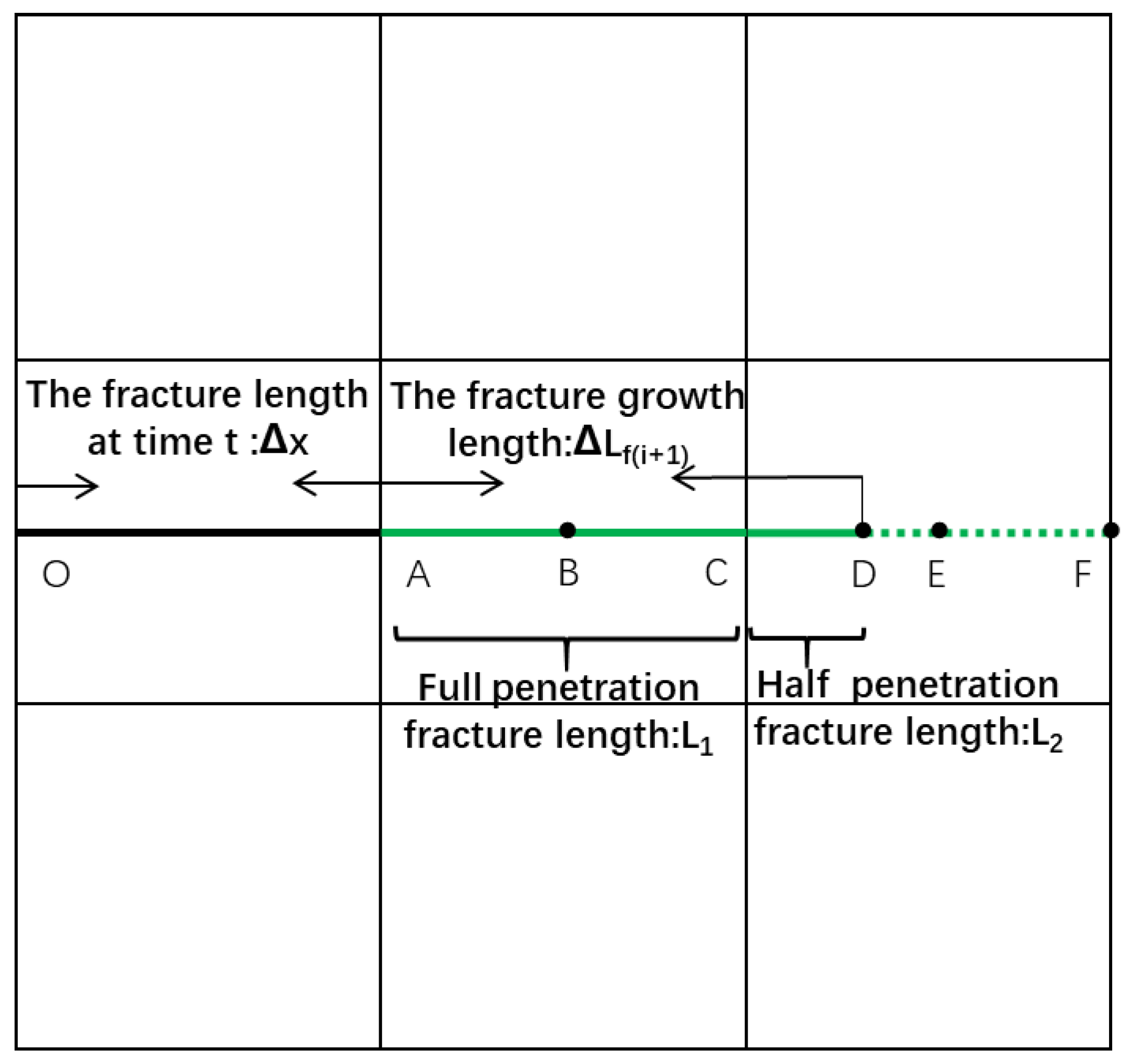
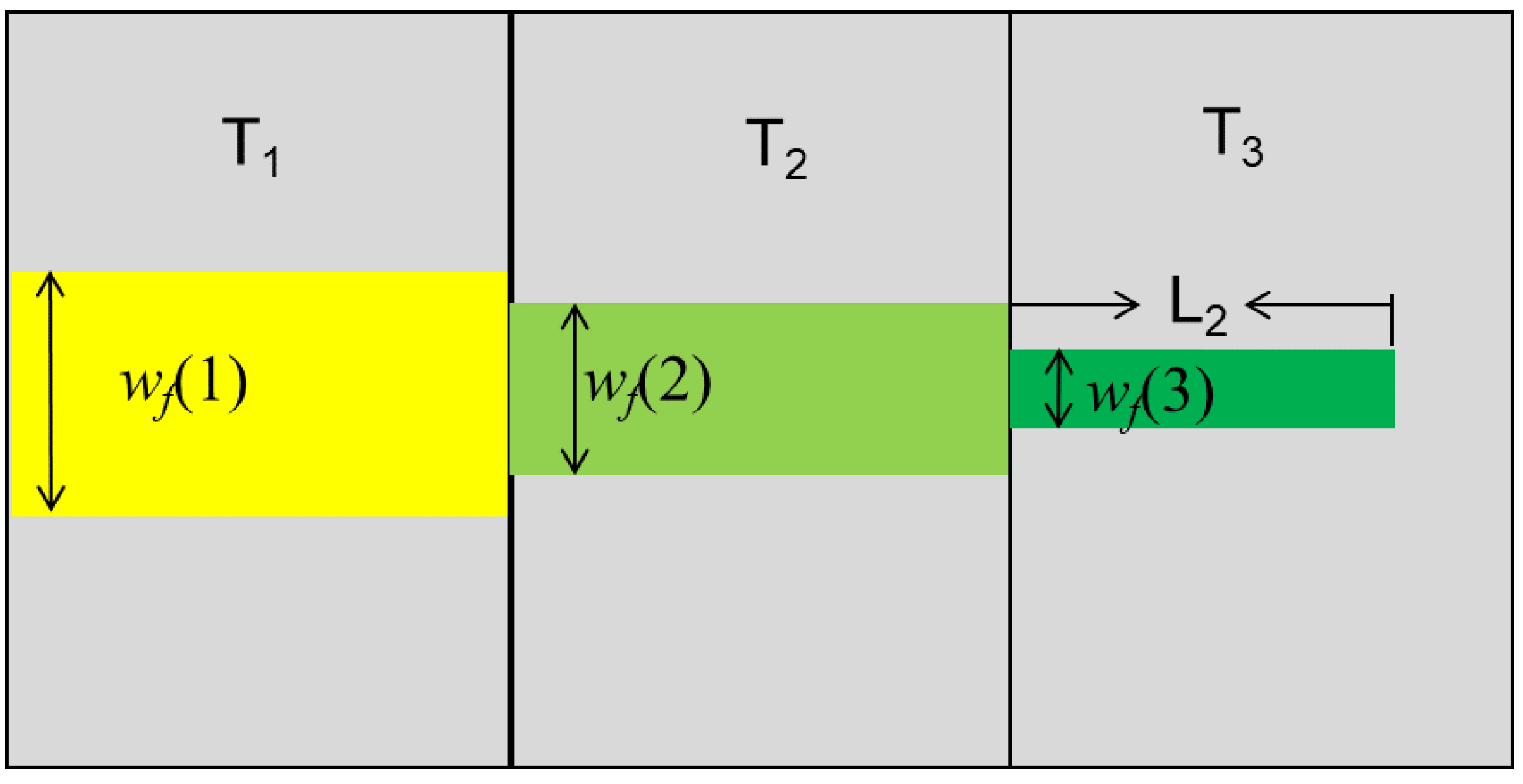
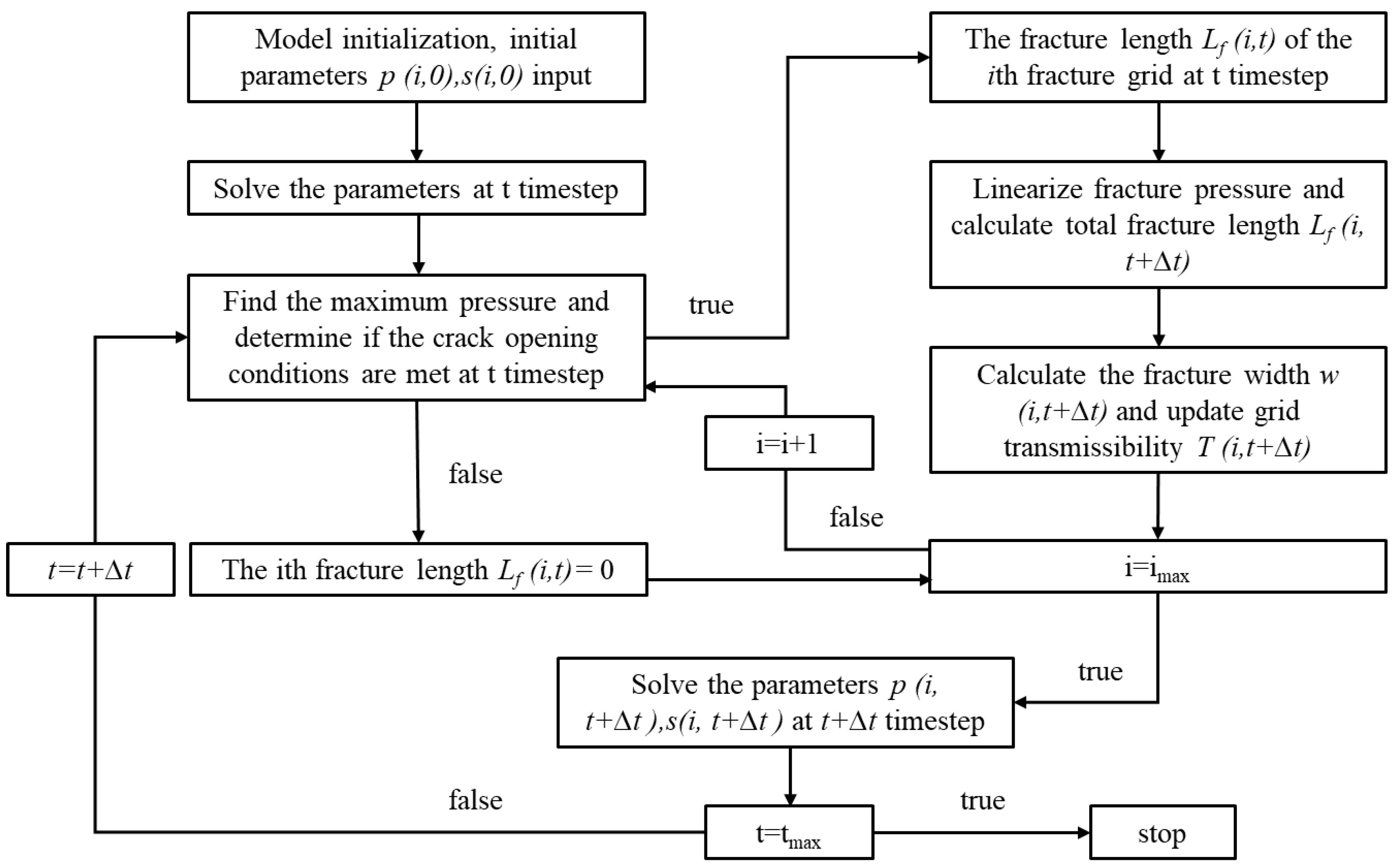
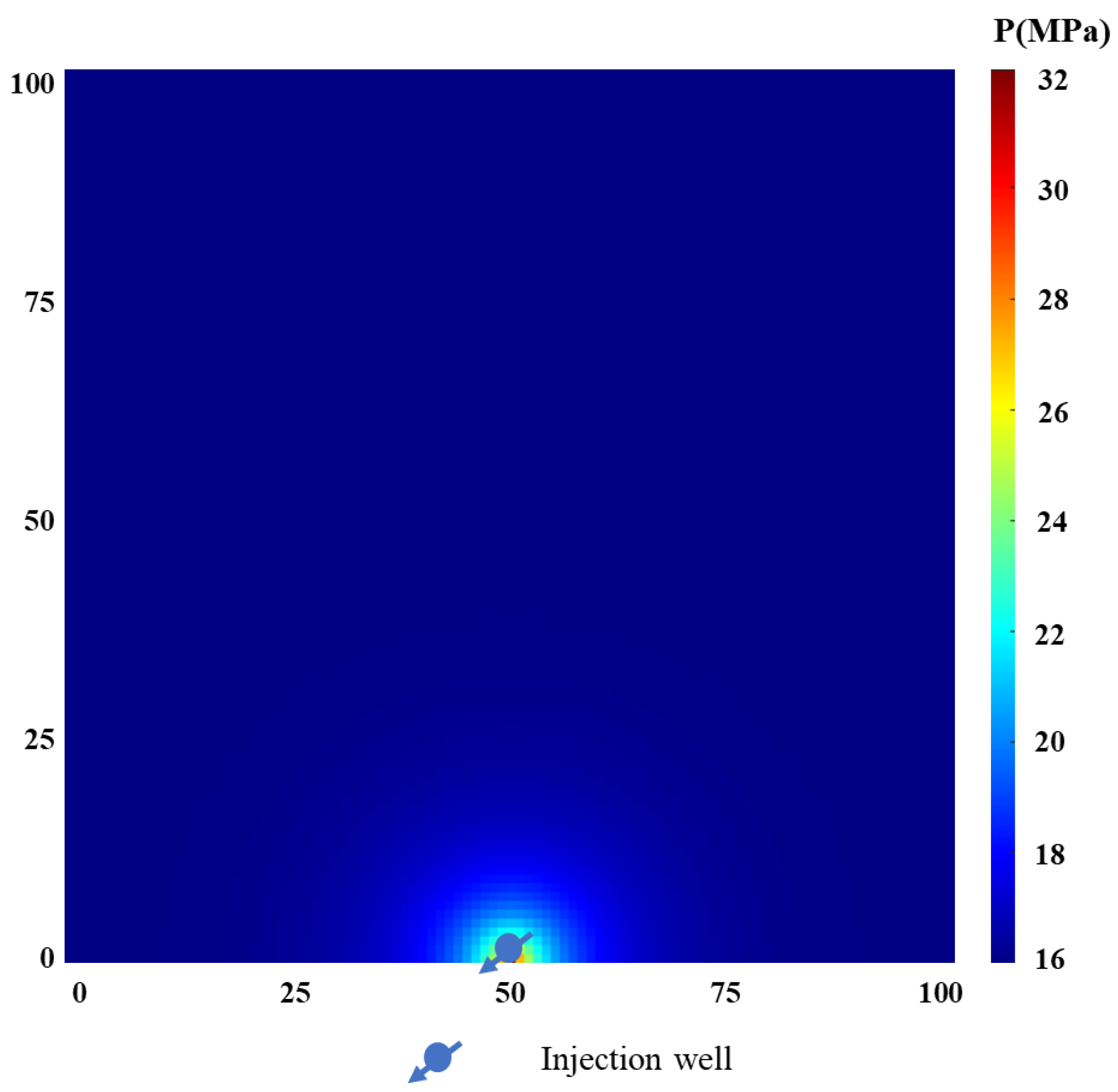



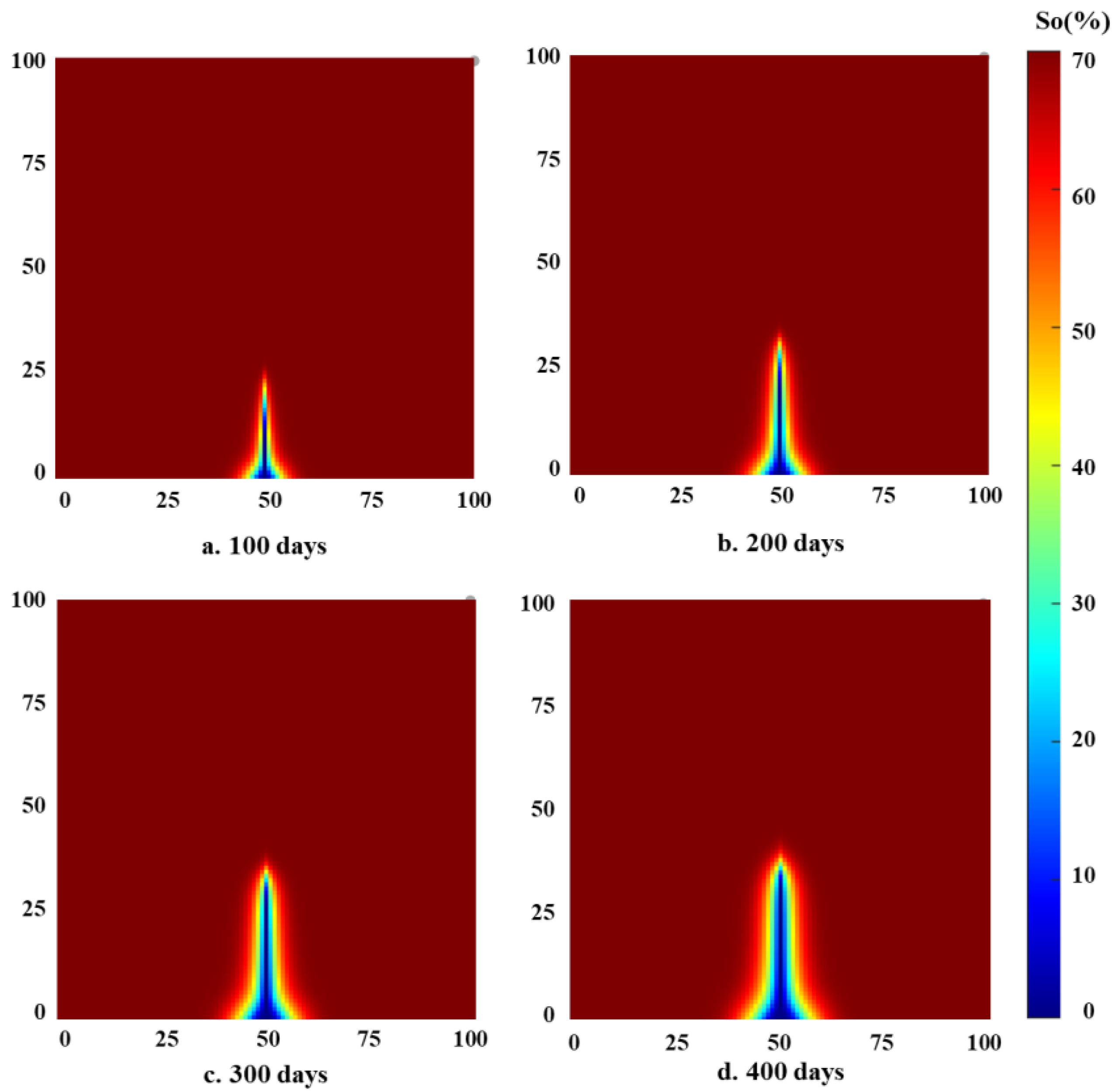

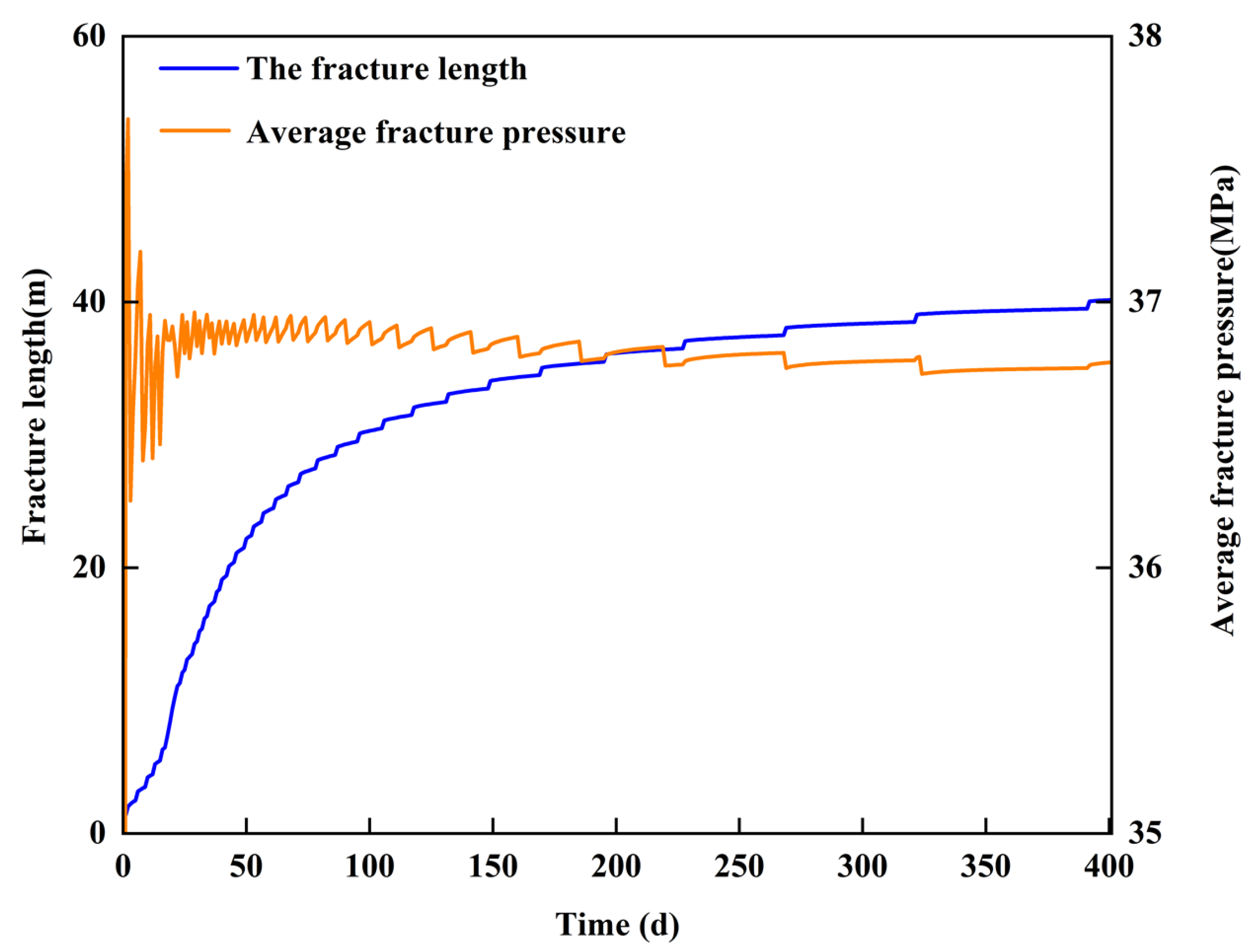

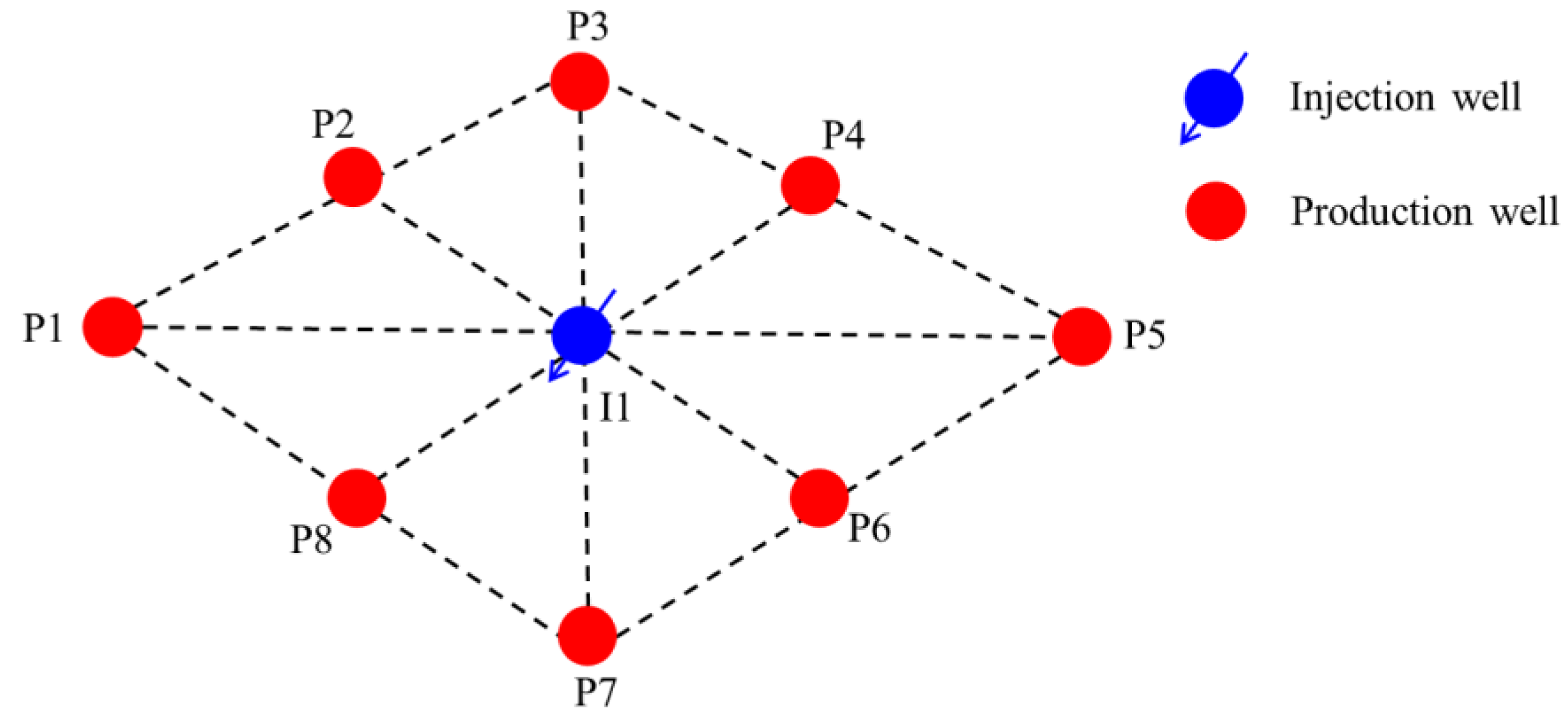
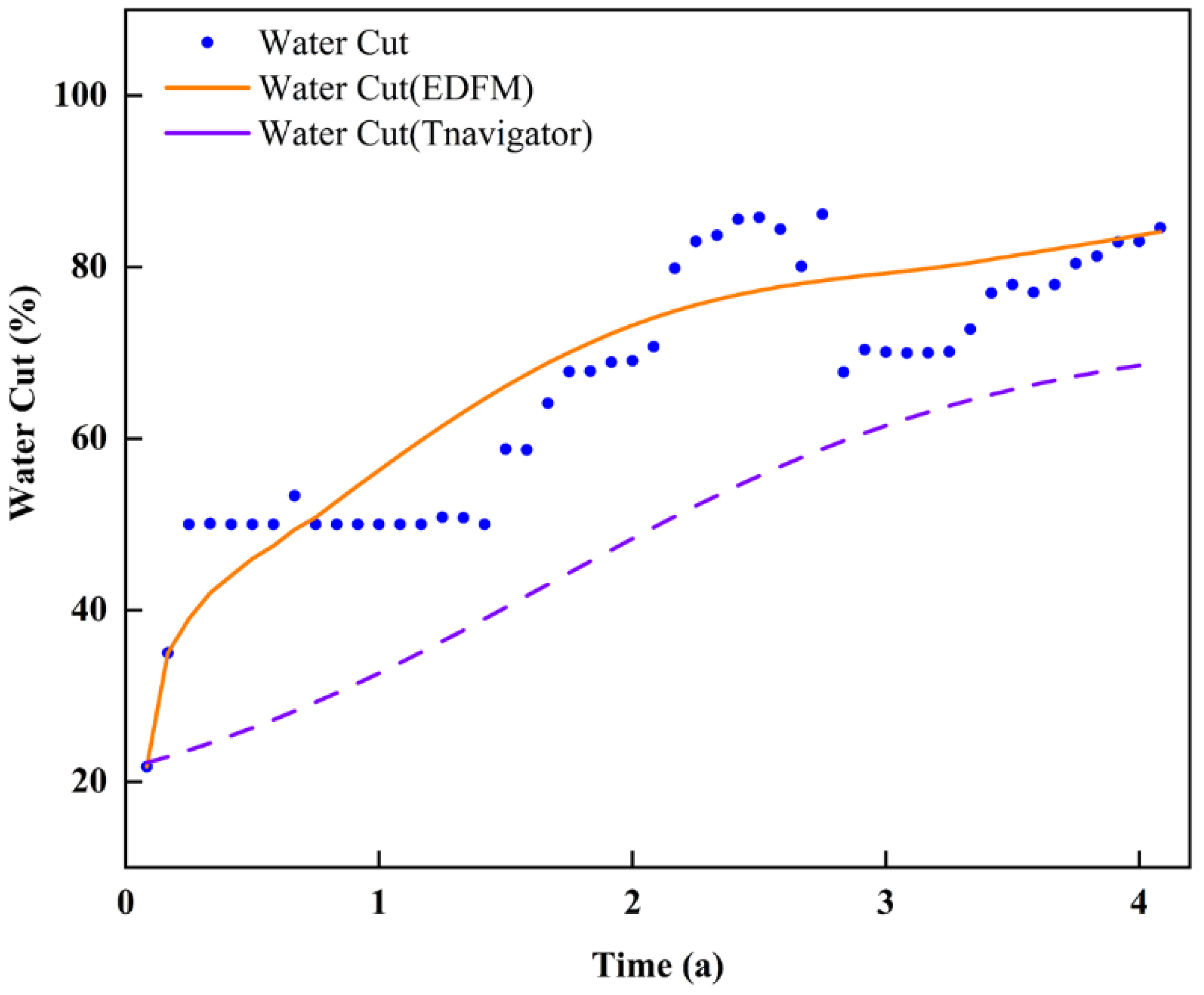
| Reservoir Parameters | Values |
|---|---|
| Initial reservoir pressure, MPa | 16 |
| Initial water saturation | 0.3 |
| Porosity | 0.13 |
| Permeability, mD | 0.3 |
| Young’s modulus, GPa | 40 |
| Poisson’s ratio | 0.3 |
| Fracture opening pressure, MPa | 33.4 |
| Rock compressibility, MPa−1 | 0.000479 |
| Reservoir Parameters | Values |
|---|---|
| Injection rate, m3/d | 24 |
| Production rate, m3/d | 3 |
| The maxnium injection pressure, MPa | 40 |
Disclaimer/Publisher’s Note: The statements, opinions and data contained in all publications are solely those of the individual author(s) and contributor(s) and not of MDPI and/or the editor(s). MDPI and/or the editor(s) disclaim responsibility for any injury to people or property resulting from any ideas, methods, instructions or products referred to in the content. |
© 2024 by the authors. Licensee MDPI, Basel, Switzerland. This article is an open access article distributed under the terms and conditions of the Creative Commons Attribution (CC BY) license (https://creativecommons.org/licenses/by/4.0/).
Share and Cite
Shi, D.; Cheng, S.; Bai, W.; Liu, X.; Cai, D. Numerical Simulation of Fracture Propagation Induced by Water Injection in Tight Oil Reservoirs. Processes 2024, 12, 1767. https://doi.org/10.3390/pr12081767
Shi D, Cheng S, Bai W, Liu X, Cai D. Numerical Simulation of Fracture Propagation Induced by Water Injection in Tight Oil Reservoirs. Processes. 2024; 12(8):1767. https://doi.org/10.3390/pr12081767
Chicago/Turabian StyleShi, Dengke, Shiqing Cheng, Wenpeng Bai, Xiuwei Liu, and Dingning Cai. 2024. "Numerical Simulation of Fracture Propagation Induced by Water Injection in Tight Oil Reservoirs" Processes 12, no. 8: 1767. https://doi.org/10.3390/pr12081767
APA StyleShi, D., Cheng, S., Bai, W., Liu, X., & Cai, D. (2024). Numerical Simulation of Fracture Propagation Induced by Water Injection in Tight Oil Reservoirs. Processes, 12(8), 1767. https://doi.org/10.3390/pr12081767







